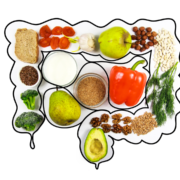Food Is Far More Than Fuel
You’ve likely heard of food referred to as fuel – I’ve even spoken that way in the past. But I’m realizing that it’s an analogy that falls short of reality. Food is far more than fuel, it is also information.
Food is what gives your body the energy and nutrients it needs to function. Your body requires fats, proteins and carbs, along with lots of micronutrients – vitamins, minerals and other compounds. All these help it functional properly.
What Do You Find In The Grocery Store?
What is the difference between what you find in a grocery store produce section and on the aisles?
Produce is food that your body recognizes and utilizes to glean the nutrients and energy it needs to function. The products found in the aisles are a lot of edible, food-like substance. These can bring hundreds of chemicals into your body, often with greatly reduced nutritional value.
If your food is from the aisles, it is a primary source of inflammation and disease. Seriously.
Though processed food is edible, it has been robbed of those valuable micronutrients I mentioned earlier and chemicals incorporated for flavor, preservation and even addictive features. It is not recognized by the body and often causes reactions that work against you.
What About The Microbiome?
I’ve written before about the microbiome that is vital for health and proper function. Sadly, many of the processed foods we consume have ingredients that either damage the microbiome, or allow certain characters to dominate the playground. This can lead to disease.
Where does that microbiome come from? It was passed to us from our mother at birth and in the months following. Assuming, of course, that you were delivered vaginally and nursed. The growing number of babies born by Caesarian and fed formula as infants, are greatly hindered in developing their microbiome, with delays of 6-10 months being common.
Once in place, the food we eat sustains our microbiome. The insoluble fiber in fruits, vegetables and whole grains is undigestible by humans, but presents a buffet for the bacteria in our gut. In return for their meal, the bacteria produce vitamins, regulate motility, transform bile acids and produce compounds that protect your digestive system.
The balance of the microbiome is disturbed by antibiotics, chemicals or other physical trauma. In this case, opportunistic bacteria can take the upper hand (so to speak) and produce compounds that increase inflammation and damage your digestive system.
How To Keep The Balance?
So how do you keep the balance and promote the positive action of your microbiome? You avoid eating processed foods, artificial sweeteners and foods. These can both kill the good bacteria and allow the opportunistic buggers to dominate.
Are fruits and vegetables a prominent part of your daily meals? They are vital for providing the right information for your body. And given that the microbiome is fed by insoluble fiber, you would be wise to avoid juiced forms and eat foods closer in form to the way they grew.
You have choices every day. The food you eat can support your microbiome, or harm it. Each bite you take can provide good information, beneficial nutrients and food for your microbiome. Or you can opt for taste teasers and low-fiber foods that will fill your belly but shift your body toward inflammation and disease.
Which choice will you make?










